باغ وحش کوچک من
صفحه 3 از 11 •  1, 2, 3, 4 ... 9, 10, 11
1, 2, 3, 4 ... 9, 10, 11 
 رد: باغ وحش کوچک من
رد: باغ وحش کوچک من
الان مادر بزرگم دوتا سگ داره:
یکی خود رکسی و یکی روبی بچه ی رکسی که الان 5 سالشه.
شومهر رکسی هم اسمش روبی بود و از سگ های پولدار محله شون!!!
البته زن و شوهر هیچ وقت پیش هم نبودن!!!

Koosha_Raisi- دوست گفتگوی لاک پشتی

- تشکر : 0
 رد: باغ وحش کوچک من
رد: باغ وحش کوچک من
به قیافه ی ملوسش که اصلاً نمی یاد خشن باشه. نازی :*

من تا الان نمی دونستم که سیاه گوش ها توی ایران هم وجود دارند. ممنون از اطلاعاتی که دادید.
خدا رو شکر که الآن سالمه. :[-o<: واقعاً خسته نباشید و مرســـــــــی

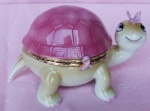
Ronia- همکار گفتگوی لاک پشتی

- تشکر : 9
 رد: باغ وحش کوچک من
رد: باغ وحش کوچک من
اين مطلب آخرين بار توسط spider در 7/28/2009, 15:48 ، و در مجموع 2 بار ويرايش شده است.
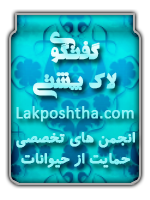
spider- کاربر خیلی فعال لاک پشتی

- تشکر : 2
 رد: باغ وحش کوچک من
رد: باغ وحش کوچک من
 من این ناز نازی رو میخوام بغلم بگیرم
من این ناز نازی رو میخوام بغلم بگیرم 
یعنی می خوایین داماد سرخونه بیارین؟؟؟؟؟؟
 :
: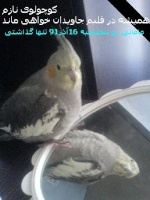
مرضیه- مدیر گفتگوی لاک پشتی

- تشکر : 29
 رد: باغ وحش کوچک من
رد: باغ وحش کوچک من
حالا که اینو پسندیده زود عقد و عروسی رو بگیرین که پشیمون نشه
شرایط نگهداری کاسکو ها چیه؟
زودتر به فکر جهیزیه و سیسمونی باشین :s/:

mahsa- همکار گفتگوی لاک پشتی

- تشکر : 6
 رد: باغ وحش کوچک من
رد: باغ وحش کوچک من
من هم ایشان را نزدیک دیدم هم این عکسشان را در facebook

اين مطلب آخرين بار توسط maryam.m در 7/28/2009, 16:59 ، و در مجموع 1 بار ويرايش شده است.

maryam.m- دوست گفتگوی لاک پشتی

- تشکر : 3
 رد: باغ وحش کوچک من
رد: باغ وحش کوچک من
آخی

دکتر معماریان رو کاملا درک می کنم
من هم آرزوی ازدواج پسرم رنبی رو دارم اما چون جامون کوچیکه نه تنها نمی تونم
براش عروس بیارم بلکه دارم خودش رو هم می فرستم بره

جدا شدن از سگی که آدم بزرگش کرده و همه نفسشه بی نهایت سخته
واقعا بچه آدمه
امیدوارم هر تصمیمی که می گیرید ، موفق باشید
و برای رنبی من هم دعا کنید که یه صاحب مهربون و دلسوز پیدا کنه
سپاس


dordon- کاربر خوب لاک پشتی

- تشکر : 3
 رد: باغ وحش کوچک من
رد: باغ وحش کوچک من
ایشالا صاحب خوب گیرش میاد

mahsa- همکار گفتگوی لاک پشتی

- تشکر : 6
 رد: باغ وحش کوچک من
رد: باغ وحش کوچک من



 حلا دیگه مسئولیتم چند برابر شده (البته هنوز نمی دانم دقیقا چندبرابر؟) 63 روز دیگه....
حلا دیگه مسئولیتم چند برابر شده (البته هنوز نمی دانم دقیقا چندبرابر؟) 63 روز دیگه....از همه دوستان بی نهایت سپاسگذارم.

Dr. Iman Memarian- دامپزشک گفتگوی لاک پشتی

- تشکر : 59
 رد: باغ وحش کوچک من
رد: باغ وحش کوچک من

 <:-p
<:-p 

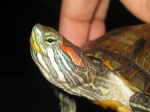
شرزاد- کاربر خوب لاک پشتی

- تشکر : 0
 رد: باغ وحش کوچک من
رد: باغ وحش کوچک من

آقای دکتر من مطمئنم که لاکپشتهای همه بچه ها هم از خوشحالی جشن گرفتن.



مه لقا- کاربر خوب لاک پشتی

- تشکر : 2
 رد: باغ وحش کوچک من
رد: باغ وحش کوچک من
New Zealand rabbits are 100% American breed despite their name. In 1916, W.S. Preshaw bred the first litter of New Zealand white rabbits with a plan to produce a rabbit that would be excellent for meat and fur trade. The original breeds that were used are unknown, but Angoras are believed to have played some part.
[ Physiology
New Zealand white rabbits were bred for their meat and fur, but their body type helped to contribute to them becoming the favorite breed of domestic rabbit. New Zealand whites have well-rounded bodies; slender and muscular faces with round cheeks; large, long back feet; and small, short front feet (Rubins). They have long perforrated ears that stand straight up. Unlike the thick, snowy fur on their bodies, their ears have shorter fur that allows the delicate pale pink of their skin to show through (Rubins). The most noticeable characteristic of New Zealand white rabbits is their bright eyes, which range in shade from pale pink to bright ruby red (Rubins).
New Zealand white rabbits have large, broad, and muscular bodies. Bucks (males) weigh between 8-10 pounds, while the does (females) weigh between 9-12 pounds (Verhallen 23-35). In addition to their greater size, females are distinguished by the presence of a dewlap, which is flap of fur below the chin that is pulled for a nesting box during pregnancies.
[edit] Albinism
New Zealand white rabbits have a genetic deviation called albinism. Albinism is caused by a lack of melanin, which is a vital pigment that gives all creatures, including humans, their skin/ fur/ hair/ eye color. The snowy coat of a New Zealand white rabbit is a normal length like other rabbit breeds.
[ Diet
The diet of a New Zealand white rabbit is no different than for any of other rabbit breeds. A high quality feed pellet (protein ~ 15-16%, along with unlimited timothy hay and fresh water and exercise will maintain a healthy individual.
[ Domestic use
In the beginning New Zealand white rabbits were not bred to be a domestic pet. Instead they were bred for their excellent fur and meat. Fryers are slaughtered at two months of age and older rabbits are sold as roasters. The rabbits with high grades of fur are used to make fur coats and fur trimmings. The lower grades are used to make felt hats and glove linings ("Commercial Rabbit Raising"). New Zealand white rabbits are the number one meat rabbit in the United States (Bare 63-65).
Along with commercial purposes, New Zealand white rabbits are also used for laboratory purposes. Over one million New Zealand white rabbits execute roles during laboratory testing. Rabbits react similarly to humans to diseases and medications. This reaction allows them to be used at pharmaceutical laboratories, the U.S. Public Health building, cancer research centers, and university hospitals. New Zealand white rabbits have been used to develop tests and drugs for diseases like diabetes, diphtheria, tuberculosis, cancer, and heart disease. The effects of skin creams, cosmetics, special diets, and food additives have also been tested on New Zealand white rabbits. (Bare 63-65)
Breeding
A female rabbit (doe) is fertile all year long. The gestation period is around 28–31 days. A few days before birth, a nest box should be provided for the new mother. The doe will pull fur from her dewlap and, along with hay or other materials provided, will create a nest. The young are called kittens and are born hairless with their eyes closed. Fur begins to grow in by day 5 or 6 and after 10 to 12 days the kits' eyes will open. At the age of three weeks their mother will begin to wean them off milk, meanwhile the kits will begin to eat hay and pellets. The average number of kits per litter is six but can range from two to twelve. Because rabbits are induced ovulators a doe can become pregnant by the simple act of mating if conditions are right. A doe can get pregnant soon after birth.
Cannibalism is rare but can happen. In the wild it is a defensive mechanism to remove all blood and dead tissue from the nesting area to avoid detection by predators. If young are stillborn or die after birth, many times the doe will ingest the remains. Males (bucks) rabbits have no part in raising the young. In the wild, bucks will kill litters to induce the female to mate with them, therefore passing along his genes.
البته نگهداری در خانه درست نیست و خپل هم فقط برای عکس گرفتن آمده روی فرش:


با تشکر

Dr. Iman Memarian- دامپزشک گفتگوی لاک پشتی

- تشکر : 59
 رد: باغ وحش کوچک من
رد: باغ وحش کوچک من
The Common Buzzard (Buteo buteo) is a medium to large bird of prey, whose range covers most of Europe and extends into Asia. It is typically between 51-57 cm in length with a 110 to 130 cm (48-60 inch) wingspan, making it a medium-sized raptor. There are around 40,000 breeding pairs in Britain. It is usually resident all year except in the coldest parts of its range, and in the case of one subspecies.
It breeds in woodland, usually on the fringes, but favours hunting over open land. It eats mainly small mammals, and will come to carrion. A great opportunist, it adapts well to a varied diet of pheasant, rabbit, other small mammals, snakes and lizards and can often be seen walking over recently ploughed fields looking for worms and insects.
Buzzards do not normally form flocks, but several may be seen together on migration or in good habitat. The Victorian writer on Dartmoor, William Crossing, noted that he had on occasions seen flocks of 15 or more at some places. Though a rare occurrence as many as 20 buzzards can been spotted in one field area, approx 30 meters apart, so cannot be classed as a flock in the general term, consisting of those males (and females) without a mate or territory. They are fiercely territorial, and, though rare, fights do break out if one strays on another pair's territory, but dominant displays of aggression will normally see off the interloper. Pairs mate for life. To attract a mate (or impress his existing mate) the male performs a ritual aerial display before the beginning of Spring. This spectacular display is known as 'the roller coaster'. He will rise high up in the sky, to turn and plummet downward, in a spiral, twisting and turning as he comes down. To then rise immediately upward to repeat the exercise.
This broad-winged raptor has a wide variety of plumages, and in Europe can be confused with the similar Rough-legged Buzzard (Buteo lagopus) and the only distantly related Honey Buzzard (Pernis apivorus), which mimics the Common Buzzard's plumage for a degree of protection from Goshawks. The plumage can vary in Britain from almost pure white to black, but is usually shades of brown, with a pale 'necklace' of feathers.
The call is a plaintive peea-ay, similar to a cat's meow.
این عکس دوست خوب من که باید به زودی بره و زندگی جدیدش را تجربه کند:


Dr. Iman Memarian- دامپزشک گفتگوی لاک پشتی

- تشکر : 59
 رد: باغ وحش کوچک من
رد: باغ وحش کوچک من
The Common Quail, Coturnix coturnix, is a small bird in the pheasant family Phasianidae. It is widespread and is found in parts of Europe, Asia and Africa with several subspecies recognized. They are also bred and kept as poultry in some parts of the world both for eggs and meat.
[edit] Description
It is a small (17 cm) rotund bird, essentially streaked brown with a white eyestripe, and, in the male, a black chin. As befits its migratory nature, it has long wings, unlike the typically short-winged gamebirds.
[edit] Habits
This is a terrestrial species, feeding on seeds and insects on the ground. It is notoriously difficult to see, keeping hidden in crops, and reluctant to fly, preferring to creep away instead. Even when flushed, it keeps low and soon drops back into cover. Often the only indication of its presence is the distinctive "wet-my-lips" repetitive song of the male. The call is uttered mostly in the mornings, evenings and sometimes at night. It is a strongly migratory bird, unlike most gamebirds.
[edit] Breeding
Upon attaining an age of 6-8 weeks, this quail breeds on open arable farmland and grassland across most of Europe and Asia, laying 6-18 eggs in a ground nest. The eggs take from 16-18 days to hatch.
[edit] Races
This species was first described by Linnaeus in his Systema naturae in 1758 as Tetrao coturnix.[2] The Eurasian race, C. c. coturnix, overwinters southwards in Africa's Sahel and India. The African race, C. c. africana, overwinters within Africa, some moving northwards from South Africa. The Common Quails of Madagascar and the Comoros belong to the same African race. The fairly numerous[3] population of the Cape Verde islands, however belong to a separate race, C. c. inopinata, while those on the Canaries, Madeira and the Azores belong to race C. c. confisa.[4]
[edit] Utilization
Exodus 16:1-13 relates how the migrating Israelites relied on migrating quail for food. It is still heavily hunted as game on passage through the Mediterranean area. This species over recent years has seen an increase in its propagation in the United States and Europe, however most of this increase is with hobbyists.
آقا پسر شلوغ من و لپو. البته لپو بسیار متفاوت از سایر گربه ها است و از بلدرچین یکم می ترسد




Dr. Iman Memarian- دامپزشک گفتگوی لاک پشتی

- تشکر : 59
 رد: باغ وحش کوچک من
رد: باغ وحش کوچک من
با تشكر
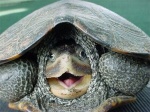
snake_eater- دوست گفتگوی لاک پشتی

- تشکر : 1
 رد: باغ وحش کوچک من
رد: باغ وحش کوچک من
خوش بحال حیوانات شما که هم آزادند هم صاحبشون انقدر بهشون توجه میکنه و دوسشون داره


maryam.m- دوست گفتگوی لاک پشتی

- تشکر : 3
 رد: باغ وحش کوچک من
رد: باغ وحش کوچک من

***
گوش قرمز بیشتر به آب وابسته است.

Koosha_Raisi- دوست گفتگوی لاک پشتی

- تشکر : 0
 رد: باغ وحش کوچک من
رد: باغ وحش کوچک من

Sahra- دوست گفتگوی لاک پشتی

- تشکر : 2
 رد: باغ وحش کوچک من
رد: باغ وحش کوچک من
عجب سیاهگوش زیبایی است. هیچ فکر نمی کردم در ایران هم چنین حیواناتی هنوز مانده باشد.
البته همه حیوانات شما قشنگ و دوست داشتنی هستند. اما لپو یک چیز دیگه است.اون را نمی خواهید واگذار کنید؟

Sahra- دوست گفتگوی لاک پشتی

- تشکر : 2
 رد: باغ وحش کوچک من
رد: باغ وحش کوچک من
آقای دکتره و یک پسر (لپو) و دخترش(جینگیل)


maryam.m- دوست گفتگوی لاک پشتی

- تشکر : 3
 رد: باغ وحش کوچک من
رد: باغ وحش کوچک من

Sahra- دوست گفتگوی لاک پشتی

- تشکر : 2
صفحه 3 از 11 •  1, 2, 3, 4 ... 9, 10, 11
1, 2, 3, 4 ... 9, 10, 11 
 مواضيع مماثلة
مواضيع مماثلة» حقیقتی کوچک
» کوچک ترین اسب جهان
» واگذاری لاک پشت برکه ای کوچک
» چند تا از نقاشی های من (محمد کوچک)

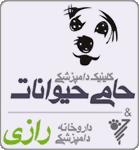
 پشتیبانی آنلاین فروم
پشتیبانی آنلاین فروم فید گفتگوی لاک پشتی
فید گفتگوی لاک پشتی


